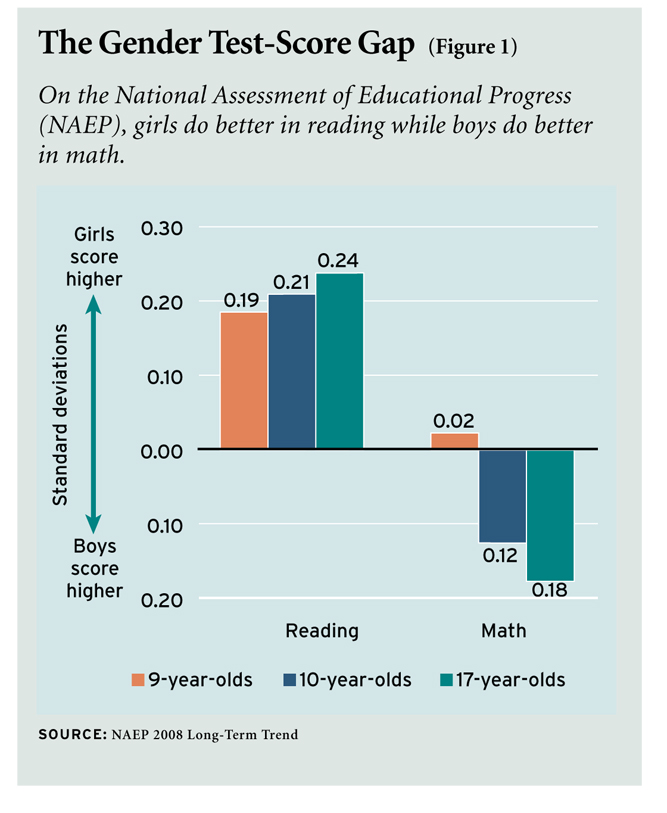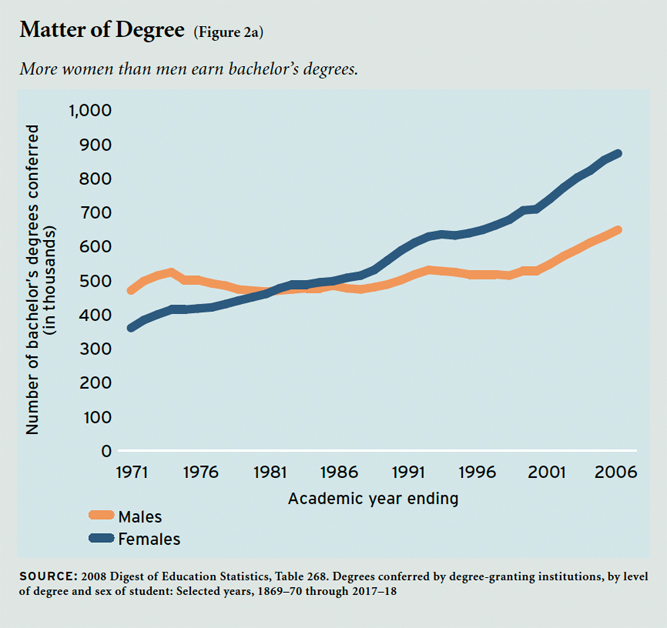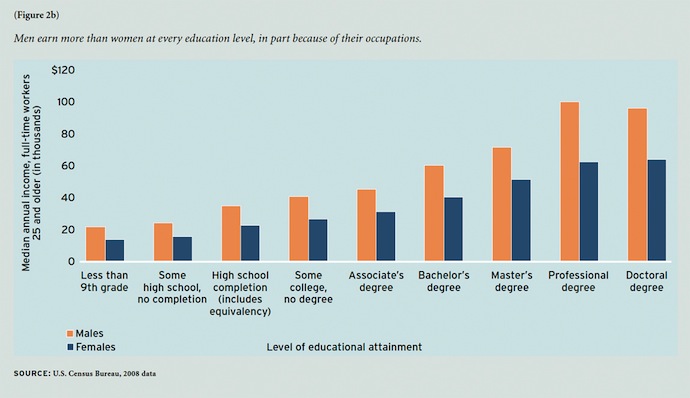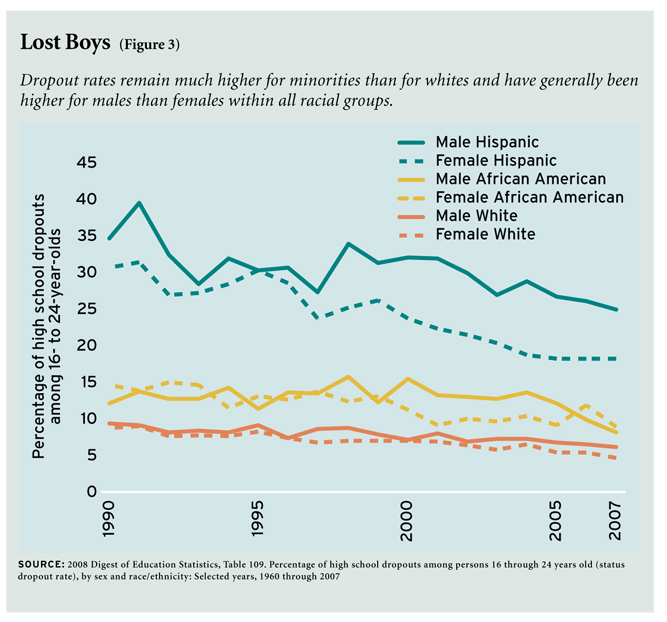Video: Richard Whitmire talks with Education Next
Debates about gender and schooling have taken a surprising turn in the past decade. After years of concern that girls were being shortchanged in male-dominated schools, especially in math and science, there has grown a rising chorus of voices worrying about whether boys are the ones in peril. With young women making up close to 60 percent of college students, critics like Richard Whitmire, former USA Today editorial writer and author of Why Boys Fail, worry that today’s schools—with their emphasis on order, sitting still, and passive learning—are much better suited to girls than to boys. Other authorities, such as Susan McGee Bailey, executive director of the Wellesley Centers for Women at Wellesley College and principal author of the 1992 AAUW report How Schools Shortchange Girls, reject such concerns and instead contend that ingrained sexism and gender roles continue to hamper K–12 schooling for both boys and girls. What does the evidence say? And what does all of this mean for policy proposals like single-sex schooling or teacher hiring? In this forum, Whitmire and Bailey sort through these questions.
Education Next: What’s the evidence that boys are doing less well in school than girls?
Richard Whitmire: Dropout and graduation rates, grades, and many test scores show boys faring poorly compared to girls (see Figure 1). But I prefer a simpler measure. Students need at least one year of post–high school study to survive in today’s marketplace, the goal wisely set this year by President Obama. In truth, they should complete two years of college. When that level of achievement is broken out by gender, men are faring badly. They go to college at lower rates and then graduate at lower rates. Let’s take Minnesota as an example. The (St. Paul) Pioneer Press just published an article on the gender gaps in that state. As of fall 2007, degrees earned by gender were bachelor’s: 58 percent female; master’s: 69 percent female; PhD: 53 percent female. Nationally, 58 percent of those earning bachelor’s degrees and 62 percent of those earning associate’s degrees are female.
For the most part this is happening because K–12 schools are shortchanging boys. Far too many boys drop out before earning a high school diploma. Worse, too many boys who do make it through high school are either unprepared for or unmotivated to do college-level work.
The conventional wisdom that women need a college degree more than men was true at one time, but is no longer. Economists at both the College Board and the U.S. Department of Education agree: men and women may earn different average salaries, but they get almost exactly the same percentage bump-up in earnings for each degree earned.
Those manufacturing jobs that men could secure with only a high school degree have been slipping away for years. In the current recession, that trend picked up speed, with more than 80 percent of the layoffs involving men. Now more than ever, men and women have equal needs to earn degrees past high school, but far more women than men are getting that message.
Susan McGee Bailey: Clearly, all our students need strong preparation for the demands of a high-tech, global world, but international data such as those provided by TIMSS (Trends in International Mathematics and Science Study) and PISA (Program for International Student Assessment) show U.S. students of both sexes performing in a mediocre fashion in comparison to their counterparts in other industrialized nations.
Focusing on the lower college completion rates for boys and blaming K–12 educators is too easy. First, the much smaller college-enrollment gap compared to the larger degree gap raises questions about college. College enrollments have been increasing for both young women and young men since the 1970s, but the increase for young women has been larger (see Figure 2a). In 1972, 53 percent of males and 46 percent of females enrolled in two- or four-year colleges immediately after graduating from high school; in 2007 the comparable figures were 66 percent of males and 68 percent of females. Women now outpace men in BA, MA, and PhD completion, but are significantly behind men in MBAs and earn law and medical degrees at slightly lower rates than men. Studies suggesting that men and women get the same benefit from a degree obscure the critical reality that women still earn less than men at every level (see Figure 2b).
During the past 20 years, discussions of educational equity have often fallen into an either/or paradigm in which one group of students has been singled out as the only group needing attention. Dropout rates illustrate the dangers of focusing too narrowly. Dropout rates have been declining for both girls and boys, with the rate of decrease greater for girls as a group. But simply looking at gender differences is not enough. Rates vary considerably by race, ethnicity, and social class, and large numbers of girls as well as boys leave school before earning a high school diploma (see Figure 3). Educators are rightly focused on ensuring high-quality instruction, developing new and improved curricular materials, and creating more engaging school environments. But educators alone cannot address the multiple factors that influence students who drop out, nor can they conduct the kinds of community outreach that can help young people find alternative routes to completing their education.
 EN: Is it all boys who are struggling or particular subsets of boys (like poor minority boys)?
EN: Is it all boys who are struggling or particular subsets of boys (like poor minority boys)?
RW: That’s the challenge raised by those who question whether boys are in trouble: this is all about income and race, not gender, they argue. It’s true that the gender gaps are especially sharp in urban areas. In July 2009, the Center for Labor Market Studies at Northeastern University released a study that tracked the students who graduated from Boston Public Schools in 2007. The conclusion: for every 167 women in four-year colleges there were only 100 men. Is poverty the cause? The male and female students came from similar streets and neighborhoods. Is race the only issue? That’s not what the study uncovered. In fact, black females were five percentage points more likely to pursue further study after high school, including community colleges, four-year colleges, and technical or vocational schools, than white males.
Gender gaps are especially profound for poor and minority males. It’s what Chicago researcher Melissa Roderick calls the “genderization of race.” Roughly translated: you won’t solve racial learning gaps unless you tackle the gender gaps. Unfortunately, school accountability regimes such as No Child Left Behind keep educators fixated solely on learning gaps associated with race and income.
Now let’s shift to the comfortable suburban districts, where both boys and girls go on to college at a high rate. Educators there see few problems, so they rarely break out the numbers by gender. There are a few exceptions. When school officials in two districts serving wealthy families—Edina outside Minneapolis and Wilmette outside Chicago—took a hard look at their gender numbers, they found wide and growing gaps. The Wilmette data were very specific, showing girls ahead in both grades and test scores.
If nearly all the students there go to college anyway, does this matter? I argue that it does. A considerable number of those boys get into selective private colleges due to gender preferences granted males by admissions officers, a practice that is both concealed and widespread. Uncovering the preferences is relatively easy. Take the U.S. News & World Report data and sort admission rates by gender. Still skeptical? Look at the most recent freshman class and break out high school grade-point averages by gender. To win admission at many private colleges (and some publics willing to risk lawsuits), females had to be more academically adept than males.
Colleges are about to be ”called out” for these admissions preferences that discriminate against women and mask the problem of boys falling behind in school. In November, the U.S. Commission on Civil Rights announced an investigation into the practice. Although the commission lacks the legal authority to act on the discrimination, mere exposure—triggering outrage from high school girls—may force colleges to curtail the favoritism.
What happens to these less-qualified males once they’re in college? Many continue their slack habits from high school, explaining much of the gender gap in college persistence rates, which count those who earn degrees within six years.
SMB: Race, sex, and income issues interact in complicated ways. NAEP (National Assessment of Educational Progress) data indicate that income and race gaps are larger than gender gaps in reading and in math scores at 8th grade, and this pattern holds for other comparisons as well. In fact, socioeconomic status has long been the single best predictor of educational success.
Teachers may be encouraging all students to continue their education beyond high school, but the message may be heard differently by male and female students, and moderated by race and income. Recent data from a study we are doing here at Wellesley Centers for Women with a large, racially diverse sample of low-income students in a large urban school district found that 95 percent of students, both boys and girls, aspired to attend college when asked in 9th and 10th grade. But if their actual college enrollment rates are in line with past district figures, far fewer will enroll in college and the numbers for young men will be lower than for young women.
Higher male dropout rates are part of the problem, but the wider range of better paid jobs open to young men immediately after high school has also been influential. Enlisting in the military after high school is an option for both sexes, but more young men than young women sign up for the armed forces. Many of these recruits are attracted by the higher education benefits the military offers. They may not be rejecting postsecondary education, but rather simply choosing a different pathway.
EN: Isn’t the problem more complex: boys are learning more math and science and girls are learning more reading?
RW: When you examine state tests, which are far better than NAEP for measuring gender gaps because they test every student every year in most grades, you see that girls have pulled even with boys in math and science. In some cases, they outscore boys in those subjects. At the same time, you see wide gaps in reading and very wide gaps in writing.
Haven’t boys always lagged behind girls in literacy skills? Yes, but literacy skills never mattered so much as they do today. In 1989 the nation’s governors met in Charlottesville, Virginia, to launch the school reforms we see today. Essentially, the goal was to put as many students as possible on a college preparation track. The key tools needed to succeed in college courses, arts or sciences, are the abilities to read quickly and accurately and write with precision and accuracy. The governors were right to set that goal, and educators were right to respond by teaching those skills in kindergarten and 1st grade. The problem arose when nobody realized that boys are ill-equipped to acquire those skills that early, at least not with the teaching methods used in the past. As a result, too many boys fall behind, conclude that school is for girls, and never try to catch up. Once boys shift their attention to video games or hip-hop music, parents and educators erroneously conclude those factors trigger the problem. In fact, boys bury themselves in games after seeing few rewards for them in school.
Educators haven’t even started redesigning the early grades to help boys absorb early literacy skills. Why this is not happening is unclear. Why has the Department of Education refused to launch a single research project into boy’s academic problems? The most likely answer: at a time when men rule the White House and Wall Street, helping males, including young boys, would amount to a political correctness violation.
SMB: I differ with Richard on NAEP. NAEP tests are specifically designed to produce reliable, comparable data over time. State tests are not. And the NAEP data are clear, if not as dramatic as some selected state data: boys, on average, perform less well than girls on tests of reading and writing skills and low-income boys do less well than higher-income boys. NAEP data also show that the gaps favor boys in science and math. While smaller than those favoring girls in reading, the gaps have by no means disappeared and they grow larger as students age (see Figure 1).
Despite widespread concern about boys’ literacy skills, we rarely look seriously at the lingering gender stereotypes that play out every day in our schools, homes, and communities. As Richard indicates, gendered assumptions about literacy are at the heart of the problem, in much the same ways that gendered assumptions about science and math have inhibited girls’ persistence and achievement in these areas. It’s a “girl thing” to read; real boys don’t sit around with a book. Parenting practices contribute to this; from an early age mothers read more to their children than do fathers. In fact, as Lise Eliot delineates in her new book, Pink Brain, Blue Brain, the way people interact with babies is based on assumptions about gender differences that have little basis in biology, but are part and parcel of our earliest socialization. “Little boys need more physical activity,” “little girls are more social,” “boys are better at math than girls”—the dichotomies are endless, and they are as dangerous as they are baseless.
Girls who do what boys have traditionally done, who become astronauts, scientists, firefighters, or soldiers, are doing things that almost everyone sees as “moving up.” The reverse is not true. It is no longer legal to advertise job openings under “female” or “male” headings, but our culture still tends to classify many jobs this way. Women make up 83 percent of librarians and 92 percent of nurses; only 15 of the Fortune 500 companies are headed by female CEOs; and women hold only 17 of 100 seats in the U.S. Senate.
Gender expectations limit both boys and girls, and at this point they may constrain young boys even more than they do girls. One of the most damaging expectations is that doing well in school is for girls. Until we confront the reality that many boys fear being viewed as less than “all boy” when achieving academically, we will only be playing around the edges of the problem.
EN: Are the problems more apparent in elementary or secondary schooling? Are there particular subjects or activities where boys are faring especially well or especially poorly?
RW: In general, girls arrive in kindergarten far more ready than boys to engage the verbal-rich curriculum that awaits them. By the end of elementary school, the gaps become significant, and in middle school they widen, in part because many schools don’t teach literacy skills after 6th grade, only “literature.” In 9th grade, where poorly prepared boys first encounter the full force of the college-readiness curriculum, you can see a pileup, or bulge, as 9th-grade classes are far larger than 8th-grade classes, the result of students being retained before entering 10th grade.
Nationally, there are 113 boys in 9th grade for every 100 girls, according to the Southern Regional Education Board. Among African Americans, there are 123 boys for every 100 girls. States are discovering that 9th grade has become their biggest dropout year. By 11th grade many boys begin to revive academically, but it’s too late to recover from their poorer grades in 9th and 10th grades.
Gender gaps are not an issue that can be easily sorted out by subject. High school girls outperform boys in many of the Advanced Placement subjects, including many of the sciences. The exceptions are physics and computer science, where boys tend to do better. Skeptics of the “boy troubles” point to SAT scores, where males outperform females, without acknowledging the gender imbalances in the test-takers: far more poor and minority girls than boys take that test.
SMB: The differences between boys and girls as they enter school have been vastly exaggerated. Yes, girls, on average, are more verbally adept at age five, but this difference is not particularly large, and many young boys are as ready to read as the girls sitting next to them. Often lost in the discussion of girls’ advantages is the reality that boys outperform girls on tests of visual and spatial abilities, and do at least as well on tests of mathematical skills at this age, and these differences widen as they advance in school.
However, on measures of fine motor skills and self-control, girls usually perform better than boys, and these skills clearly contribute to early school success. Classrooms that use manipulative materials to practice spatial skills are as necessary as those that give special attention to literacy skills for students in need of help in that area. Literacy is critical and boys need encouragement and support, but this does not mean that all girls are fine readers and it certainly does not mean that gaps in science and math that show girls at a disadvantage should be dismissed. When more than 75 percent of undergraduate degrees in the highly paid fields of computer science and engineering are awarded to young men, the majority of them white, the idea that we no longer need focus on these issues for girls and for students of color does not hold up.
Looking carefully at the gendered assumptions that underlie our education system gives us a clearer picture not only of the problems confronting boys in attaining competencies in reading and writing, but of a range of school problems that include gender violence, the continuing imbalance favoring boys in school athletics, and the over-referral of boys—particularly boys of color—and the under-referral of girls, to special education programs. Each of these issues reflects assumptions about the “appropriate” roles of men and women. No discussion of educational equity can ignore the rising rates of dating violence, sexual harassment, and bullying in our schools. When young men and boys think that it is acceptable to verbally harass or physically attack girls under the guise of “manliness,” something is decidedly out of kilter. Educators must do more to help both boys and girls see beyond this dangerous construction of masculinity.
EN: Do boys learn differently than girls? Are schools better organized for the ways in which girls learn? Or is the problem something in American culture writ large?
RW: This is not an American issue. In England and Australia, the gender gap is a topic of regular newspaper stories. What’s interesting in England is the attention paid to the especially sharp decline in educational performance among white boys from blue-collar families. You can see that in this country as well, with steeply growing college-going gender gaps within that group. The issue in Australia came to a head in 2003 when the government issued a lengthy report on the topic. The conclusion: literacy skills are the culprit. Researchers in England have reached roughly the same conclusion.
In the United States the federal government has never investigated the issue, most likely because it is considered “controversial.” When the issue arises, the basic premise that boys are in trouble gets attacked by national feminist groups or professors from women’s studies departments. Their attitude is understandable: the first to point out that boys were in trouble were conservatives, who blamed the feminists for creating school environments that were hostile to boys. I find no evidence that feminists are to blame for the problem. Their only “fault” lies in continuing to deny that the problem exists.
SMB: Different children learn differently, but differences between individual boys and between individual girls are much larger than those between girls as a group and boys as a group. Expectations based on gender remain rampant in American culture, and indeed, in cultures around the world. As Richard notes, there has been significant attention paid to the boy half of gender issues in England and Australia. Researchers in England who have studied a range of sociocultural approaches to the problem of boys’ achievement report that one of the most successful involves directly addressing the “lad culture.” By helping boys who are seen as leaders in their peer group improve in school, they create a climate where other boys see academic achievement as “cool.” Exam grades for boys in schools in the study increased significantly.
Creating an environment where academic achievement is seen as something all boys, as well as all girls, should aspire to is critical. In those U.S. school systems where boys do well, this is invariably the case. The majority of these schools are in more affluent districts, where parents have college degrees and encourage their sons and their daughters to do well academically, or in less advantaged communities where the community itself has rallied behind educational goals. The culture of the school reflects the culture of the surrounding community. We need more public discussion of the value of education and its multiple individual and societal benefits. When we talk only of test scores and economic rewards, we present too narrow a view.
EN: Is it a problem that so few teachers are men?
RW: Male teachers continue to disappear from classrooms. Their numbers are at 24 percent, a record low. What’s interesting is the rapid disappearance of male teachers from the middle school classrooms. Elementary schools never had many male teachers and high schools still retain a respectable number of males. In some middle schools, however, you simply won’t find a male teacher. Combine that with the fact that middle school is the time when the gender gaps widen the most and you have an obvious culprit, right? I don’t buy it. It wouldn’t hurt to have more male teachers, especially in the middle school years, but I’m not convinced that suddenly boosting the number of male teachers would close any gender gaps.
Some researchers (see “The Why Chromosome,” research, Fall 2006) have documented modest gains made by boys taught by male teachers, but in researching my book I found that the schools that educate boys as well as girls pay little or no attention to the gender of the teacher. Rather, they pour enormous resources into how literacy is taught.
SMB: It is not surprising that there are so few male teachers. K–12 teaching remains a “woman’s job,” with a limited career path and poor pay considering the preparation required. Questions laced with homophobia about why a man would want to teach children are rampant. The more advanced the education level, the more men in the teaching ranks. At the university level the balance has shifted entirely, with women significantly underrepresented among tenured faculty. Excellent teaching is not a matter of gender, but the absence of men in K–12 classrooms sends subtle messages about what is “female” and “male,” influencing students in ways that remain largely invisible and understudied.
EN: Is single-sex education a viable strategy for addressing the problem?
SMB: Research that examines the effectiveness of single-sex K–12 education and controls for socioeconomic background and degree of parental involvement, both crucial factors in educational attainment, is woefully lacking. We must examine curricular programs and teaching practices used in successful single-sex and coed programs, the kinds of students they help most, and how these programs and practices can work for more students in a wider range of settings. An example of this approach is research showing that girls benefit from science instruction that relates the material to real-world problems—and so do boys. When evaluating single-sex education,
we must not ignore a crucial purpose of public education—developing effective citizens. We need to consider the tradeoffs we may be making in sex-segregating students, closing off opportunities for learning from and with each other.
RW: Here’s my problem with single-sex education: The Bush Department of Education flipped on the green light for public schools to carry out single-sex education, but never commissioned a single study that would instruct schools on how to do it. (I’m choosing my words carefully here: meta-analyses of single-sex education don’t guide classroom instruction.) Some states—South Carolina comes to mind, which was determined to do something for their flailing boys—gave that green light a broad embrace, unleashing several hundred programs. Unfortunately, not that many of those programs are first-rate. And if academic breakthroughs don’t materialize, those single-sex programs will be dismantled, perhaps prematurely.
EN: Are there programs that are much more effective for boys? What are the traits or approaches that they have in common?
RW: Most important is a refusal to let students slip behind. I see a lax attitude toward males, “Don’t worry, Mom, boys will be boys. Your son will catch up,” as the single biggest problem. In fact, a lot of boys never do catch up. Two of the schools I profile in Why Boys Fail weren’t even aware they were closing gender gaps; that wasn’t their goal. Their goal was to focus on literacy skills and refuse to let any child slip behind. They took great pride in their success and seemed surprised when it was pointed out they had leveled the gender gaps.
SMB: Research studies on effective schools have shown remarkably similar findings for 30 years. Schools that set high standards for all, involve parents, provide firm discipline and an orderly, encouraging environment, and where teachers are respected and engaged are more successful. Such schools do not as easily fall into the black hole of differential expectations for girls and boys, or one racial or ethnic group over another.
EN: What other options might policymakers or reformers consider?
SMB: We should take a page from the successful, ongoing efforts that address the lingering lag in girls’ and women’s participation in STEM (Science, Technology, Engineering, and Mathematics) fields and leadership positions: 1) mentoring and role-modeling programs that involve more men in schools, particularly men who hold other than traditionally male jobs so that students see men in a variety of careers; 2) a national fathers’ reading campaign to engage more fathers in reading to their children; and 3) increased funding for innovative programs that engage students in literacy activities in and out of school. When “reading like a girl” is as acceptable for boys as doing science and math well is becoming for girls, we will begin to make real progress toward gender-equitable education for all our students.
RW: The U.S. Department of Education needs to launch an Australian-style investigation into the boys problem. Once the key issues are identified, follow-on research projects can target specific teaching strategies for teachers. One critical need: national research into what works and doesn’t work with single-sex education.
Not all the solutions lie within the K–12 world, however. Colleges should eliminate from high school grade-point averages the results from 9th grade—when many boys struggle to make the transition from middle school. And colleges need to step in to help make badly needed adjustments to K–12 accountability systems. State high school graduation standards don’t match college readiness requirements. Given the higher college dropout rates for men, that mismatch appears to be hurting males the most.







